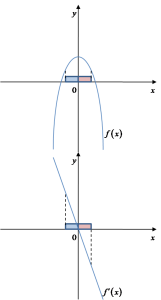Function Extrema Lecture 7
Topic: Sufficient condition for the existence of a function’s extremum (change in the sign of the derivative).
Summary
As we found out in the previous Lecture, just because the function’s derivative at a point is equal to 0 doesn’t necessarily mean that the function itself reaches an extremum at that point. So, here we’re going to talk about what conditions are sufficient for a function to reach an extremum at some point.
Sufficient Conditions for the Existence of an Extremum
Assume that in some neighborhood of the point x_0, the function f \left(x \right) has a finite derivative f' \left( x \right):
- If in this neighborhood of x_0, to the left of x_0, the values of the function’s derivative are positive, and to the right of x_0 negative – then the function assumes a maximum at the point x_0
- If in this neighborhood of x_0, to the left of x_0, the values of the function’s derivative are negative, and to the right of x_0 positive – then the function assumes a minimum at the point x_0
Indeed, according to the Lemma on the Monotonicity of Functions introduced in the previous Lecture, if the function’s derivative ![]() takes positive values, it means that the function
takes positive values, it means that the function ![]() is increasing. If, however, the derivative
is increasing. If, however, the derivative ![]() takes negative values, it means that the function
takes negative values, it means that the function ![]() is decreasing.
is decreasing.
If, therefore, the derivative ![]() “changes sign”, it also indicates a change in the monotonicity of the function
“changes sign”, it also indicates a change in the monotonicity of the function ![]() , for example in case 1:
, for example in case 1:
The derivative to the left of ![]() is positive, and to the right negative. This means that the function
is positive, and to the right negative. This means that the function ![]() to the left of
to the left of ![]() is increasing, and to the right decreasing. It must look something like this:
is increasing, and to the right decreasing. It must look something like this: In the graph above, we have the graph of the function
In the graph above, we have the graph of the function ![]() (at the top) and its derivative
(at the top) and its derivative ![]() . It can be seen that in the “left” vicinity of the point
. It can be seen that in the “left” vicinity of the point ![]() (marked in blue) the derivative
(marked in blue) the derivative ![]() takes positive values, and the function
takes positive values, and the function ![]() is increasing. In the “right” vicinity of the point
is increasing. In the “right” vicinity of the point ![]() (marked in red) the derivative
(marked in red) the derivative ![]() takes negative values, and the function
takes negative values, and the function ![]() is decreasing.
is decreasing.
It’s clear that such a change always means the existence of a maximum at the point ![]() .
.
THE END
In writing this post, I used…
1. “Differential and Integral Calculus. Volume I.” G.M. Fichtenholz. Published in 1966.
Click here to revisit the necessary condition for the existence of an extremum (previous Lecture) <–
Click to return to the lectures page on studying the variability of functions
